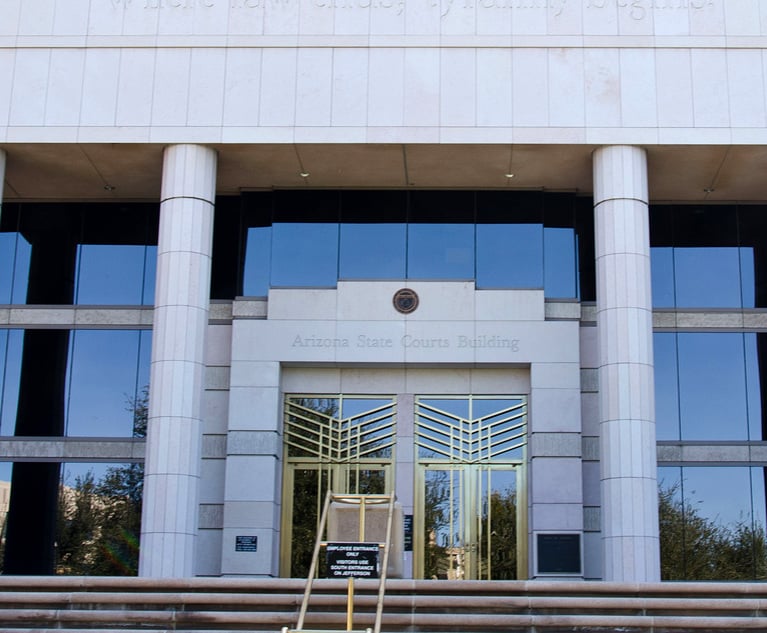Litigation support and e-discovery: A clear path
When The Ramones pleaded to be given "Shock Treatment", I somehow doubt that they were presciently pleading for help with project management issues in e-discovery. But I sense that shock is a common ailment for which some lawyers crave treatment. That shock has common symptoms: projects delivered late; inadequate budgetary reporting; insufficient explanation of problems; and multiple reporting lines. Indeed, this seems to be a global rather than a UK problem: recent Socha-Gelbmann surveys in the US reach similar conclusions.
May 06, 2009 at 10:08 PM
9 minute read
 The use of good project management skills during an e-discovery process can help you navigate your way through a mass of information. Sanjay Bandhari reports
The use of good project management skills during an e-discovery process can help you navigate your way through a mass of information. Sanjay Bandhari reports
When The Ramones pleaded to be given "Shock Treatment",
I somehow doubt that they were presciently pleading for help with project management issues in e-discovery. But I sense that shock is a common ailment for which some lawyers crave treatment. That shock has common symptoms: projects delivered late; inadequate budgetary reporting; insufficient explanation of problems; and multiple reporting lines. Indeed, this seems to be a global rather than a UK problem: recent Socha-Gelbmann surveys in the US reach similar conclusions.
E-discovery is a relatively immature industry and practices are evolving. We are now seeing many more corporate clients taking direct control of e-discovery across all of their cases rather than relying on external legal advisers to act as a filter on a case-by-case basis. Such clients often have a higher expectation of compliance with generally accepted project management (PM) standards such as PRINCE 2 and PMBOK.
These approaches are not easily applied to the vast majority of
e-discovery projects and tend to be anathema to most lawyers (who often regard them as over-engineering) but a demand for more formalised PM standards seems inevitable. The greater involvement of corporate clients also appears to be shifting the focus from an assessment of pure cost to an assessment of value. Moreover, for UK lawyers, there is an intense focus on proportionality. Thus it is not just cost, but cost-effectiveness that matters and that is where good PM techniques can make a difference.
The purpose of this article is to consider some practical techniques to put clients in the driver's seat. There is no single PM approach advocated as better than others. The following are offered as thoughts based on experience, not a prescription to cure-all PM ailments. These thoughts are split into two categories: overarching PM techniques (addressing techniques and issues across all stages of a project) and process stage PM techniques (addressing techniques specific to typical e-discovery data processing stages such as the Electronic Discovery Reference Model (EDRM).
There are four principal categories of overarching PM techniques offered: stakeholder management, communications management, budgetary management and risk management.
Typically, e-discovery exercises are managed by the service provider as a production line, from data collection through to review. Often, different people have expertise in the different stages. If the client is exposed to all of those people, they can feel that reporting lines are confused. In our experience it is good stakeholder management to clearly set out some responsibilities with individuals at the service provider adopting one or more of the following roles (dependent upon the needs of the case):
- an engagement owner (for example, an engagement partner or director) with overall responsibility for the quality of work;
- a project manager as the single point of contact for all workstreams. In selecting the project manager/team, consider appointing a project manager with formal PM qualifications (such as PRINCE 2) or experience;
- stage owners for the different stages from identification through to review;
- an independent quality assurance director to act as a fresh pair of eyes; and
- an independent relationship management director (for the escalation of issues beyond the engagement management team)
It is also important for the clients (both the external lawyers and the corporate client) to have at least an equivalent PM team with whom the dedicated project manger can liaise. More complex assignments may require an equivalent stakeholder framework as set out above. Where representing a number of diffuse clients (for instance, a tower of reinsurers or a group of co-defendants), it may be necessary to form a steering group among the clients.
A single project manager is also essential to an effective communications plan. Thought needs to be given to the form and frequency of communications. Consider regular weekly calls. In periods of intense activity, daily calls can be helpful (for instance, during the early stages of a pilot project, a review exercise or an intense period of processing). This enables the actions to be tweaked iteratively to meet the emerging needs of the review.
An important discipline in such intense periods is to have reports and calls at fixed times irrespective of progress – the temptation is to put off a report or a call until a particular piece of work is completed. The point of the reports and meetings in such intense periods is precisely to manage those activities which, for perfectly understandable reasons, are taking longer than expected.
 The service provider and clients should discuss the form of communication. In most projects, calls and email reports will suffice. In some cases, it might be useful to consider setting up an e-room. In more complex cases with multiple workstreams, it is very easy to get lost in the weeds of a particular workstream, so it may be worth considering using a visual dashboard to monitor progress, enable the PM team to maintain a helicopter view and enable the client/court to consider proportionality.
The service provider and clients should discuss the form of communication. In most projects, calls and email reports will suffice. In some cases, it might be useful to consider setting up an e-room. In more complex cases with multiple workstreams, it is very easy to get lost in the weeds of a particular workstream, so it may be worth considering using a visual dashboard to monitor progress, enable the PM team to maintain a helicopter view and enable the client/court to consider proportionality.
Many of these techniques apply equally to budgetary management. Our approach is to seek to enable the clients and the court to perform a regular costs-benefit analysis to manage proportionality. The aim should be that the tap can be turned off at any point. This may involve costs forecasts on a quarterly, monthly, weekly or, sometimes, daily basis depending on the stage of the project, with similar frequency of reporting progress against forecast. Again, on more complex cases, it might be worth considering the use of visuals by workstream.
Typically, there may be a number of stages in an e-discovery exercise, and the data will be prioritised to try to focus on the most relevant information quickly and cost-effectively. There may be a number of workstreams and a number of actions. It is important to manage the risks across all workstreams by maintaining appropriate risk registers and action logs with clear responsibilities, timetable for resolution and recording of decisions.
There are likely to be specific risks around data privacy, data security and possibly specific confidentiality concerns (for example, national security or public interest immunity for government clients). These issues merit a separate article in themselves. For current purposes, suffice to say that it may be sensible to articulate and agree a specific written protocol for addressing such risks.
There are a number of process stage PM techniques that may be helpful at particular stages from identification through to review. Articulating a written preservation plan is often sensible. In more complex organisations, with multiple or diverse stakeholders, this may need to be devolved to sub-areas, perhaps via a standard form questionnaire. We would also recommend a collection tracking schedule prioritised by custodian and data source as appropriate. This may be in the form of a simple excel spreadsheet with traffic lights to indicate progress. In more complex cases, a simple database may be useful.
When it comes to processing and loading data onto a review tool, to be proportionate, it is likely that data will be prioritised by custodian, data source, file type, dates or keywords. A processing and loading schedule would be useful. Again, an excel spreadsheet with a traffic light system to monitor progress periodically will suffice in most cases (a simple database may be required in more complex cases). In effect, what is being created here is a network of multiple parallel pipelines into a giant reservoir of documents. Any particular item of data has to go through the same stages in the pipeline, but different items of data will be in different places on that journey into the reservoir in accordance with the priorities of the case. In complex cases, it may be useful, therefore, to have visuals to more effectively track the overall position.
In the review phase, it may be useful to maintain some daily/weekly reports on lawyer review rates (e.g. document decisions per day) and number of documents remaining to be reviewed to load balance work appropriately and estimate review completion dates. There are often very good reasons why one individual is reviewing at a slower rate (for example, the source they are reviewing has a much greater density of relevant documents). It is useful to monitor this regularly (particularly in the early stages of review as reviewers become familiar with the data and the review tool).
In larger or more complex cases, it might be sensible to perform a scoping exercise or a pilot project on a limited set of data. This could be useful, for instance, at an investigative stage or to test a keyword review strategy. In such cases, it is useful to retain metrics of attrition rates (i.e. the amount of data filtered out by the keyword strategy) to enable such attrition rates to be projected across the remaining data set and produce projections of time and cost for processing and review of the remaining data.
Effective PM techniques can help to alleviate some of the pain associated with e-discovery and to avoid nasty shocks. In our experience, at the heart of effective project management is regular, honest and transparent communication based upon strategies clearly articulated in writing. As someone once said, it's good to talk.
Sanjay Bandhari is head of e-discovery services at Ernst & Young.
This content has been archived. It is available through our partners, LexisNexis® and Bloomberg Law.
To view this content, please continue to their sites.
Not a Lexis Subscriber?
Subscribe Now
Not a Bloomberg Law Subscriber?
Subscribe Now
NOT FOR REPRINT
© 2025 ALM Global, LLC, All Rights Reserved. Request academic re-use from www.copyright.com. All other uses, submit a request to [email protected]. For more information visit Asset & Logo Licensing.
You Might Like
View All

Some Elite Law Firms Are Growing Equity Partner Ranks Faster Than Others
4 minute read
KPMG's Bid To Practice Law in US On Hold As Arizona Court Exercises Caution
Trending Stories
- 1Public Notices/Calendars
- 2Wednesday Newspaper
- 3Decision of the Day: Qui Tam Relators Do Not Plausibly Claim Firm Avoided Tax Obligations Through Visa Applications, Circuit Finds
- 4Judicial Ethics Opinion 24-116
- 5Big Law Firms Sheppard Mullin, Morgan Lewis and Baker Botts Add Partners in Houston
Who Got The Work
J. Brugh Lower of Gibbons has entered an appearance for industrial equipment supplier Devco Corporation in a pending trademark infringement lawsuit. The suit, accusing the defendant of selling knock-off Graco products, was filed Dec. 18 in New Jersey District Court by Rivkin Radler on behalf of Graco Inc. and Graco Minnesota. The case, assigned to U.S. District Judge Zahid N. Quraishi, is 3:24-cv-11294, Graco Inc. et al v. Devco Corporation.
Who Got The Work
Rebecca Maller-Stein and Kent A. Yalowitz of Arnold & Porter Kaye Scholer have entered their appearances for Hanaco Venture Capital and its executives, Lior Prosor and David Frankel, in a pending securities lawsuit. The action, filed on Dec. 24 in New York Southern District Court by Zell, Aron & Co. on behalf of Goldeneye Advisors, accuses the defendants of negligently and fraudulently managing the plaintiff's $1 million investment. The case, assigned to U.S. District Judge Vernon S. Broderick, is 1:24-cv-09918, Goldeneye Advisors, LLC v. Hanaco Venture Capital, Ltd. et al.
Who Got The Work
Attorneys from A&O Shearman has stepped in as defense counsel for Toronto-Dominion Bank and other defendants in a pending securities class action. The suit, filed Dec. 11 in New York Southern District Court by Bleichmar Fonti & Auld, accuses the defendants of concealing the bank's 'pervasive' deficiencies in regards to its compliance with the Bank Secrecy Act and the quality of its anti-money laundering controls. The case, assigned to U.S. District Judge Arun Subramanian, is 1:24-cv-09445, Gonzalez v. The Toronto-Dominion Bank et al.
Who Got The Work
Crown Castle International, a Pennsylvania company providing shared communications infrastructure, has turned to Luke D. Wolf of Gordon Rees Scully Mansukhani to fend off a pending breach-of-contract lawsuit. The court action, filed Nov. 25 in Michigan Eastern District Court by Hooper Hathaway PC on behalf of The Town Residences LLC, accuses Crown Castle of failing to transfer approximately $30,000 in utility payments from T-Mobile in breach of a roof-top lease and assignment agreement. The case, assigned to U.S. District Judge Susan K. Declercq, is 2:24-cv-13131, The Town Residences LLC v. T-Mobile US, Inc. et al.
Who Got The Work
Wilfred P. Coronato and Daniel M. Schwartz of McCarter & English have stepped in as defense counsel to Electrolux Home Products Inc. in a pending product liability lawsuit. The court action, filed Nov. 26 in New York Eastern District Court by Poulos Lopiccolo PC and Nagel Rice LLP on behalf of David Stern, alleges that the defendant's refrigerators’ drawers and shelving repeatedly break and fall apart within months after purchase. The case, assigned to U.S. District Judge Joan M. Azrack, is 2:24-cv-08204, Stern v. Electrolux Home Products, Inc.
Featured Firms
Law Offices of Gary Martin Hays & Associates, P.C.
(470) 294-1674
Law Offices of Mark E. Salomone
(857) 444-6468
Smith & Hassler
(713) 739-1250









